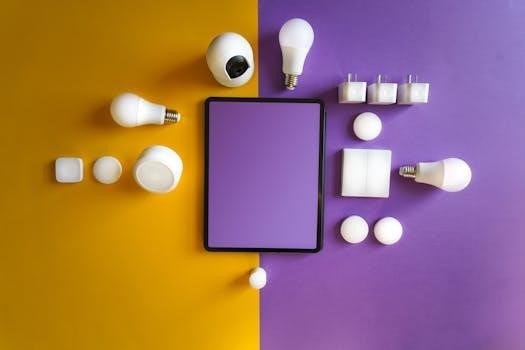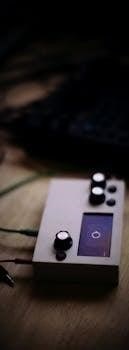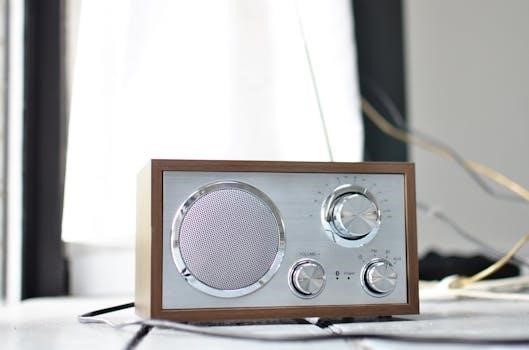3-Way Switch Wiring Diagram PDF⁚ An Overview
A 3-way switch allows control of lights from two locations, offering convenience. Many diagrams show how to wire 3-way switches. These diagrams often come in PDF format for easy access. They are great for DIY projects and electrical repairs. They offer different arrangements of 3-way circuits.

Components of a 3-Way Switch Wiring System
A 3-way switch wiring system comprises several key components essential for its operation. These include⁚
- Wires⁚ These consist of a LINE (hot), a LOAD, a neutral conductor, and a pair of travelers. The hot wire provides the power source, the neutral wire completes the circuit, and the travelers allow the switches to communicate.
- Two 3-way switches⁚ Unlike regular switches, these have three terminals. One is a common terminal (often black), and the other two are traveler terminals (usually brass).
- Ground wire⁚ Typically green or bare copper, it’s crucial for safety, providing a path for electrical faults to prevent shocks.
- Junction boxes⁚ These house the wiring connections, providing a safe and organized space for the wires.
- Wire connectors⁚ Used to securely join wires, ensuring a reliable electrical connection.
- Light fixture⁚ The ultimate destination of the electrical current, controlled by the 3-way switches.
Understanding these components is fundamental when working with 3-way switch systems. Correctly identifying each wire’s function is essential for successful troubleshooting and wiring.

3-Way Switch Terminal Color Coding
Understanding the color coding of terminals on a 3-way switch is crucial for proper wiring and avoiding potentially dangerous mistakes. Each terminal serves a specific purpose, and the color helps identify its function. Here’s a breakdown of the standard color coding⁚
- Green⁚ This terminal is always designated for the ground wire. Connecting the bare copper or green insulated ground wire to this terminal ensures a safe path for electrical faults, protecting against shocks. It’s a critical safety component and should never be omitted.
- Brass⁚ The two brass-colored terminals are the traveler terminals. These terminals connect to the traveler wires, which run between the two 3-way switches. The traveler wires carry the electrical signal that allows the switches to alternate the light’s on/off state from either location.
- Black⁚ Typically, the black-colored terminal is the common terminal. This terminal connects to either the hot wire from the power source or the wire leading to the light fixture, depending on the wiring configuration. It’s important to identify whether the power source or the light is connected to this terminal for correct wiring.
Always double-check the manufacturer’s instructions for the specific 3-way switch you are using, as slight variations can occur. However, the color coding mentioned above is the standard in most cases. Correctly identifying and connecting wires to their corresponding terminals based on color coding is essential for a functional and safe 3-way switch system.

Wiring Configurations⁚ Power to Light vs. Power to Switch
When wiring a 3-way switch system, one of the initial considerations is determining where the power source enters the circuit. The power can either run to the light fixture first or directly to one of the 3-way switches. These two configurations require different wiring methods.
- Power to Light⁚ In this configuration, the hot wire (power source) runs directly to the light fixture first. From the light fixture, wires are then run to both 3-way switches. This setup often involves running a 3-wire cable from the light fixture to each switch. The advantage of this configuration is that it can sometimes simplify wiring if the power source is closer to the light fixture than to the switches. This is suitable when the power source is physically located at the light fixture’s location.
- Power to Switch⁚ Alternatively, the hot wire can run directly to one of the 3-way switches first. In this case, the power source is connected to the common terminal of the first switch. Wires are then run from the first switch to the second switch and the light fixture. This configuration is common when the power source is closer to one of the switch locations. This typically requires a 3-wire cable running between the two switches, as well as a separate cable running from the second switch to the light fixture.
Choosing the correct configuration depends on the layout of your wiring and the location of the power source. Understanding the differences between these two configurations is crucial for selecting the appropriate wiring diagram and ensuring a properly functioning 3-way switch system. Carefully analyze your specific situation to determine which configuration is best suited for your needs.
3-Way Switch Wiring with Multiple Lights
Extending a 3-way switch setup to control multiple lights involves a few more steps but follows the same basic principles as a single light configuration. The key is to wire the lights in parallel so that each receives the proper voltage and can be controlled simultaneously by the two 3-way switches. Here’s how you can approach this⁚
- Wiring Lights in Parallel⁚ Connect all the lights in a parallel circuit. This means that the hot wires of all the lights are connected together, and the neutral wires of all the lights are connected together. This ensures that each light receives the full voltage, regardless of how many lights are in the circuit.
- Connecting to the Switches⁚ The wiring from the switches to the lights remains largely the same as with a single light. The wire coming from the common terminal of the second 3-way switch, which would normally go directly to a single light, is instead connected to the joined hot wires of all the lights. The neutral wires from the lights are connected to the neutral wire in the electrical box.
- Power Source Considerations⁚ As with a single light setup, the power source can either enter at one of the switches or at one of the light fixtures. If the power enters at a switch, the wiring to the first light is the same as in the single light setup. If the power enters at a light fixture, that light fixture becomes the junction point for distributing power to the other lights in the circuit.
- Using Wiring Diagrams⁚ When wiring multiple lights, it’s especially important to use a clear and accurate wiring diagram. A diagram specifically designed for multiple lights will show how to connect the wires correctly to ensure that all lights are controlled by the 3-way switches. These diagrams often come in PDF format, making them easy to print and reference while you are working.
Remember to always follow safety precautions when working with electrical wiring. Turn off the power at the circuit breaker before starting any work, and use a voltage tester to ensure that the wires are not live. If you are not comfortable working with electrical wiring, it’s best to hire a qualified electrician.

Troubleshooting 3-Way Switch Wiring
Troubleshooting a 3-way switch circuit can be tricky, but with a systematic approach, you can identify and fix the problem. Here are some common issues and steps to resolve them⁚
- Lights Don’t Turn On⁚ If the lights don’t turn on at all, the first step is to check the power source. Ensure the circuit breaker hasn’t tripped. Use a voltage tester to confirm that power is reaching the switches. If the power is present, the issue might be with the wiring. Check the connections at each switch to make sure they are secure and properly connected according to the wiring diagram. A loose connection or a wire connected to the wrong terminal can prevent the circuit from working.
- Lights Stay On Continuously⁚ If the lights stay on regardless of the switch positions, there might be a short circuit or a wiring error. Inspect the wiring at each switch and light fixture for any crossed wires or damaged insulation. A common cause is a short between the hot and neutral wires. Correct any wiring errors and replace any damaged wires.
- One Switch Doesn’t Work⁚ If one of the switches doesn’t seem to be working, the problem might be with the switch itself. Use a multimeter to test the continuity of the switch. When the switch is in one position, the multimeter should show continuity between the common terminal and one of the traveler terminals. When the switch is flipped, it should show continuity between the common terminal and the other traveler terminal. If the switch doesn’t show continuity in either position, it’s likely defective and needs to be replaced.
- Flickering Lights⁚ Flickering lights can be caused by loose connections or a faulty switch. Check the wiring at each switch and light fixture to ensure that all connections are tight. If the connections are secure, try replacing the switches one at a time to see if that resolves the issue.
- Incorrect Wiring⁚ If you’ve recently installed or rewired the switches, double-check that the wiring matches the wiring diagram. Incorrect wiring is a common cause of 3-way switch problems. Pay close attention to the connections of the common, traveler, and neutral wires.
When troubleshooting, always turn off the power at the circuit breaker before working on the wiring. Use a voltage tester to confirm that the power is off. If you’re not comfortable working with electrical wiring, it’s best to hire a qualified electrician.
Safety Precautions Before Wiring
Before commencing any electrical wiring work, especially with 3-way switches, adhering to strict safety precautions is paramount to prevent electrical shock, fire hazards, and potential injuries. Electricity can be dangerous if not handled properly, so taking these steps seriously is essential.
- Always Disconnect Power⁚ The most critical step is to turn off the power to the circuit you’ll be working on. Locate the appropriate circuit breaker in your electrical panel and switch it to the “off” position. To ensure the power is completely off, use a non-contact voltage tester to verify that no electricity is flowing through the wires you’ll be handling. Test each wire individually, including the black (hot), white (neutral), and bare copper or green (ground) wires. This step is non-negotiable and should be performed every time you work with electrical wiring.
- Use Appropriate Tools⁚ Employ insulated tools specifically designed for electrical work. These tools have rubber grips that provide a barrier against electrical shock. Ensure your tools are in good condition, with no cracks or damage to the insulation. Essential tools include insulated screwdrivers, wire strippers, pliers, and a voltage tester. Avoid using tools that are not designed for electrical work, as they may not provide adequate protection.
- Wear Safety Gear⁚ Protect yourself by wearing safety glasses to shield your eyes from sparks or debris. Rubber gloves can provide an additional layer of insulation against electrical shock. Avoid wearing jewelry or metal objects that could conduct electricity.
- Understand the Wiring Diagram⁚ Before you start wiring, carefully study the 3-way switch wiring diagram. Ensure you understand the connections and the purpose of each wire. If you’re unsure about any aspect of the wiring, consult a qualified electrician. Incorrect wiring can lead to dangerous situations, including short circuits and fire hazards.
- Inspect Wires⁚ Check the condition of the wires before making any connections. Look for frayed insulation, corrosion, or any other signs of damage. Replace any damaged wires to ensure a safe and reliable connection. Use wire connectors that are appropriate for the wire gauge and application.
- Work in a Well-Lit Area⁚ Ensure you have adequate lighting to see the wiring clearly. A well-lit workspace reduces the risk of errors and improves safety.
- Double-Check Your Work⁚ After completing the wiring, carefully double-check all connections to ensure they are secure and properly made. Use the wiring diagram as a reference to verify that everything is connected correctly.
- Test the Circuit⁚ After you’ve completed the wiring and double-checked your work, turn the power back on at the circuit breaker. Test the 3-way switches to ensure they are working correctly. If you encounter any problems, turn the power off immediately and re-inspect the wiring.
By following these safety precautions, you can minimize the risk of electrical accidents and ensure a safe and successful wiring project. If you’re not comfortable working with electricity, it’s always best to hire a qualified electrician.
